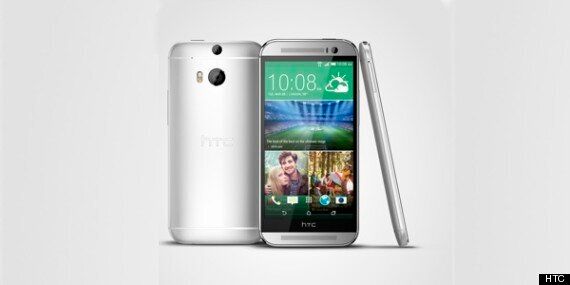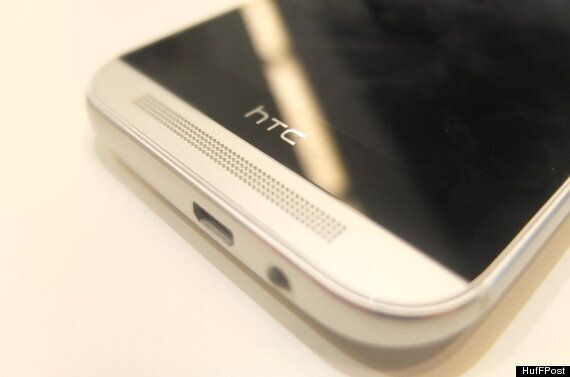HTC has unveiled the One (M8), it's latest flagship smartphone at an event in London, with a unique 'dual lens' UltraPixel camera.
And it's already out.
HTC unveiled its latest smartphone at an event at London's Olympia, and have begun sales immediately at 30 stores around the UK.
HTC Europe president Phil Blair said the phone represented the company's "next step in the journey to perfection".
But should you buy one? And what's new?
Here are the key specs of the new device.
- 5-inch, 441 pixels-per-inch HD screen
- 16GB on-board storage, expandable up to 128GB via MicroSD
- Qualcomm 801 2.3Ghz processor
- 2,600 mAh battery with 40% performance improvement
- Upgraded front-facing speakers for astonishingly clear and loud sound
- Simpler, faster 'UltraPixel' camera, with a second lens for depth capture
- 5-megapixels front-facing 'Selfie' camera

The HTC One (M8) builds on the critical success of its original HTC One, improving the device with a larger screen, refined software and a unique 'dual camera' designed to make it possible to focus and refocus any photo after taking it.
The (M8) also has vastly improved dual front speakers, a five-megapixel 'selfie camera' designed to make taking self portraits easier than ever, and updates to its Zoe (photo sharing) and BlinkFeed (content 'magazine') apps.
We had a chance to play with one already -- here's what we thought:
Impressions:
The HTC One (M8) is housed in a sleek, smooth all-metal case. The 'signature' colour is a silvery grey, which also features a horizontally-brushed finish. It also comes in 'Arctic' white, which is very smart, and a glitzier 'Amber' gold.
HTC said the M8 was designed to be comparable to jewellery. And to our eyes that attention to detail shows in the carefully carved edges, the thin bezel on the screen and the subtly designed ports.
As with the original One, HTC has made its hardware features the real focus of its device -- the speakers, the camera and the front-facing lens.
The dual-lens camera -- which is the most unusual addition - takes what was good about the original 'UltraPixel' snapper, which focused on sensor 'quality' rather than pure megapixel count, and improves the fundamentals while adding some nifty new tricks. At its most basic, the new version is faster, with improved focus speed and a refined software interface. There's a full manual mode to adjust all the settings including shutter speed, and save those settings as a 'custom' camera for easy access later. The Zoe photo sharing and 'memories' app is now fully automatic and runs in the background collecting your image into neat films and albums.
The camera is also functionally better, with the 2nd lens adding the ability to shift the point of focus on every image, with no apparent loss of speed. It remains to be seen whether you'll use this as much as HTC wants, but it's a good feature which is on by default, and so should see some use. Better still is the gimmicky but genuinely impressive '3D shift' mode, by which you can 'look around' any image you take thanks to the depth of field information. You'll have to see it to understand, but it's a neat 3D trick and should impress your friends at least.
HTC also made a point to stress the quality of its front-facing camera, which in most smartphones is lumbered with a low-res sensor but in the age of the Selfie demands an upgrade. As such the HTC One (M8) comes with a vastly improved 5-megapixel wide-angle camera, which incorporates a tap-anywhere shutter and easy editing options to beautify your vanity shots.
The HTC One also introduced genuinely ground-breaking hardware sound in the form of two front-facing speakers. The (M8) improves on this with totally redesigned speakers that are 25% louder, and also clearer thanks to a new multi-phase amp, which should help maintain clarity even at the highest volumes. Again, it's one to check out in person but if you watch a lot of content on your small screen, it's a big plus in the One (M8)'s favour.

Elsewhere the (M8) packs in a lot of improvements we'll have to cover in more detail in our review.
They include a neat LED-style 'Dot View' cover, which displays key information like notifications and weather in a deliberately lo-res, faux-retro style. There's also a new power-saving mode, an improved 'Blinkfeed' magazine app for the homescreen (soon to be available on Google Play, along with Zoe), new theme customisation options and some new gesture controls. If you raise the phone like a camera (side on) it will launch the camera app without you touching the screen.
The overall feel is of a phone which adds genuine, rock-solid hardware improvements to a formula which was already a winner.
Immediately it shoots right up to the top of the Android charts, joined by Sony's Z2 and the Samsung Galaxy S5 -- both of which are yet to appear on the market in the UK.
Yes, the M8 lacks the former's waterproofing and ultra-high pixel camera, and the latter's heart-rate monitor and sleek form-factor. But it's neck and neck, and genuinely different, and should prove to be a big winner.